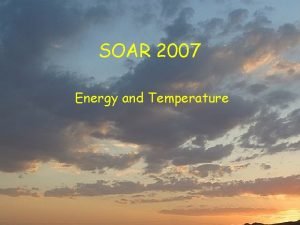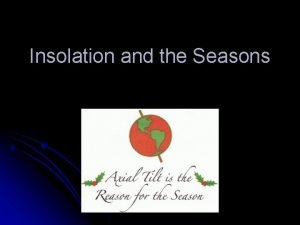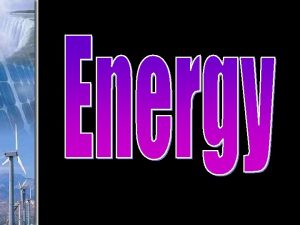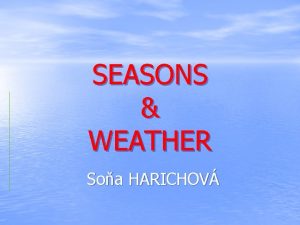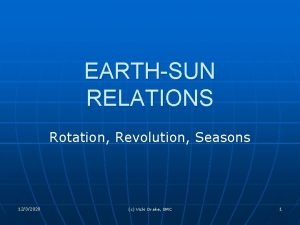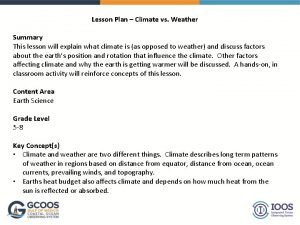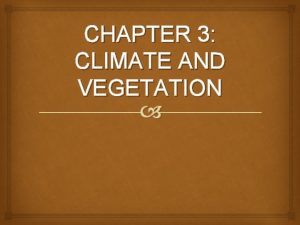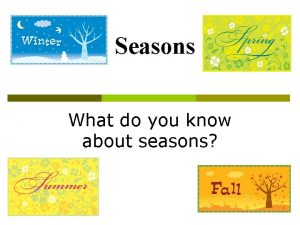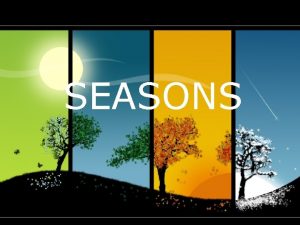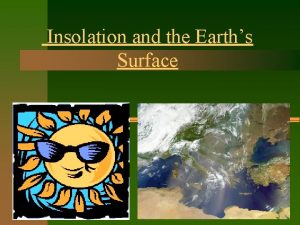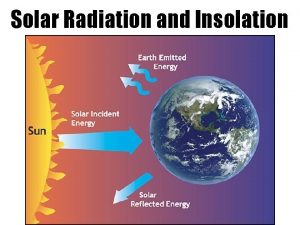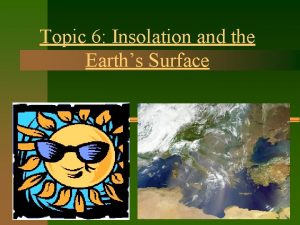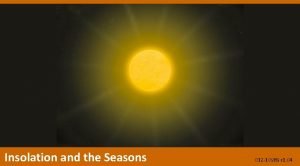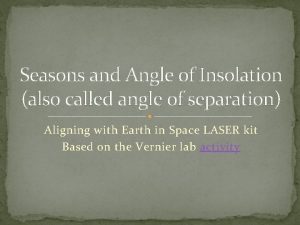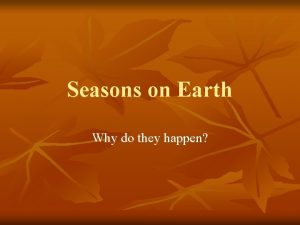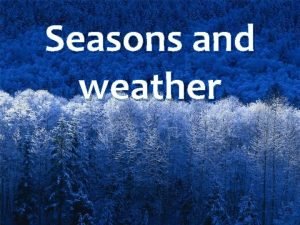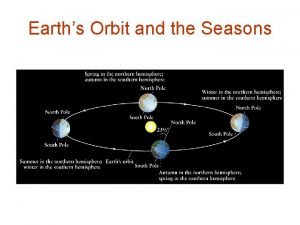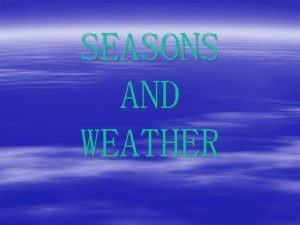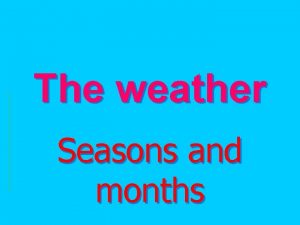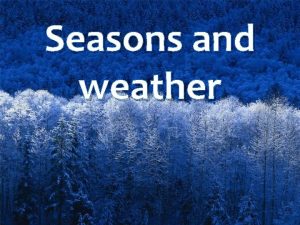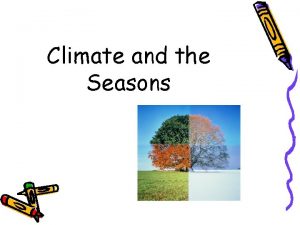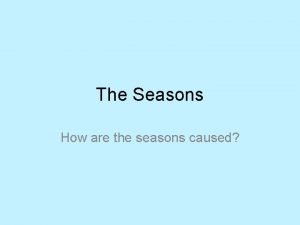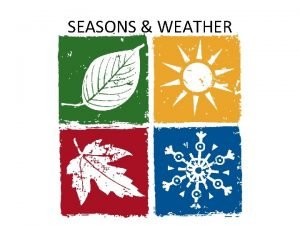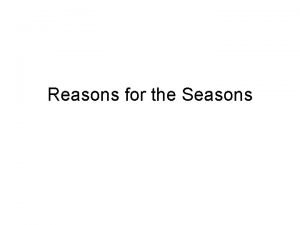Insolation and the Seasons What is Insolation Insolation































- Slides: 31

Insolation and the Seasons

What is Insolation? Insolation = INcoming SOLar radi. ATION!! Not to be confused with insulation, which is the stuff you put in your attic to keep your house warm in winter.

What is Insolation? l Energy received from the sun. It can be absorbed, reflected or reradiated.

Variations of Insolation The intensity of insolation received is not the same at every point on Earth. l The reasons for this are: l 1. Earth’s shape l 2. Latitude changes l 3. Seasonal changes l 4. Time of day l

Variations of Insolation l 1. Earth’s Shape l Earth is a sphere, not flat, therefore at any given time, there is just one place on Earth getting direct (90º) sunlight.

Variations of Insolation 2. Change in Latitude l The intensity of insolation is greatest at the equator, since it always gets direct (90º) rays of sunlight. l l With each degree in latitude you go up or down from the equator the intensity of insolation DECREASES.

Variation of Insolation l 3. Seasonal Changes l The angle of insolation changes as the Earth revolves around the sun during it’s 365. 24 day cycle.

Notice when the sun is lower in the sky you will have a longer shadow.


Variation of Insolation l 4. Time of Day l On any given day, the altitude (height) of the sun varies from zero (at sunrise) to a maximum (noon), back to zero again (at sunset).

By the way, wear sunscreen During the spring and summer months, the peak sun burning times are 10 am to 4 pm. l WHY? l

Variation of Insolation In addition to the angle of insolation changing, the duration of insolation changes as well. l The duration of insolation is the time between sunrise and sunset.




Seasons Video

Main Reason for the Seasons Main reason for the seasons: Earth is tilted on it’s axis 23. 5º

What Changes Do We Observe During The Seasons? 1. The sun’s altitude (height) changes with the seasons. l Highest = summer (June 21) l Lowest = winter (December 21) l NEVER directly overhead at our latitude!!

What Changes Do We Observe During Seasons? 2. Sunrise and Sunset positions change with the seasons. South of E/W in fall and winter North of E/W in spring and summer

Azimuth of sunrise changes with season North of East Dawn South of East

What Changes Do We Observe During Seasons? 3. Daylight length – Duration of Insolation Shortest on Winter Solstice, Dec. 21 12 hours on Equinox Longest on Summer Solstice, June 21.

Reasons for the seasons animation

The Summer Solstice l l l June 21 - longest daylight of the year. Sun at highest altitude at noon. 24 hrs of daylight at North Pole. Direct sun ray at 23° 30’ north latitude – also known as the Tropic of Cancer. Most likely to get sun burned. Sunrise = N of E, Sunset = N of W

The Winter Solstice l l l Dec. 21 - shortest daylight of the year. Sun at lowest altitude at noon. 24 hrs. of darkness at North Pole. Direct sun ray at 23° 30’ south latitude – also known as Tropic of Capricorn Not too much chance of sunburn, unless you ski. Sunrise = S of E , Sunset = S of W

The Equinoxes l l l Sept. 21 – Autumnal (Fall) Equinox March 21 - Vernal (Spring) Equinox 12 hrs of daylight, 12 hrs of night. The word equinox means equal day and equal night. Direct sun ray at Equator (0º) Sunrise = E, Sunset = W. This is also called Due East and Due West.

Realize that: June and July get approximately the same insolation l May and August get the same insolation l April and September get the same insolation. l l Wear Sunscreen.

Is Distance Important to Seasonal Change? Farthest away on July 4, 4 Closest on Jan. 3. NO! Earth’s orbit is an ellipse (oval).


Water with the appropriate temperature will only be found in tropical regions

What dates correspond to each figure? 2 1 – December 21, Winter Solstice 3 1 2 – March 21, Spring (vernal) Equinox 3 – June 21, Summer Solstice 4 4 – September 23, Fall (autumnal) Equinox

 Angle of insolation lab
Angle of insolation lab Ocean current
Ocean current What is insolation
What is insolation Insolation of earth
Insolation of earth Whats insolation
Whats insolation Seasons and weather
Seasons and weather Seasons months
Seasons months 23 1/2
23 1/2 Parts of globe
Parts of globe Continental location
Continental location Seasons of the year song
Seasons of the year song Hình ảnh bộ gõ cơ thể búng tay
Hình ảnh bộ gõ cơ thể búng tay Bổ thể
Bổ thể Tỉ lệ cơ thể trẻ em
Tỉ lệ cơ thể trẻ em Voi kéo gỗ như thế nào
Voi kéo gỗ như thế nào Glasgow thang điểm
Glasgow thang điểm Chúa sống lại
Chúa sống lại Các môn thể thao bắt đầu bằng tiếng chạy
Các môn thể thao bắt đầu bằng tiếng chạy Thế nào là hệ số cao nhất
Thế nào là hệ số cao nhất Các châu lục và đại dương trên thế giới
Các châu lục và đại dương trên thế giới Cong thức tính động năng
Cong thức tính động năng Trời xanh đây là của chúng ta thể thơ
Trời xanh đây là của chúng ta thể thơ Mật thư tọa độ 5x5
Mật thư tọa độ 5x5 Làm thế nào để 102-1=99
Làm thế nào để 102-1=99 Phản ứng thế ankan
Phản ứng thế ankan Các châu lục và đại dương trên thế giới
Các châu lục và đại dương trên thế giới Thể thơ truyền thống
Thể thơ truyền thống Quá trình desamine hóa có thể tạo ra
Quá trình desamine hóa có thể tạo ra Một số thể thơ truyền thống
Một số thể thơ truyền thống Cái miệng nó xinh thế
Cái miệng nó xinh thế Vẽ hình chiếu vuông góc của vật thể sau
Vẽ hình chiếu vuông góc của vật thể sau

